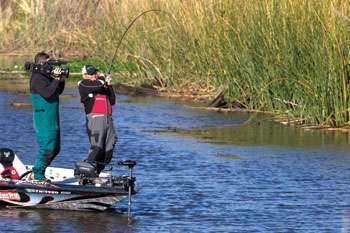
In the bass world, there are winders and grinders. Bassmaster Elite Series angler Greg Hackney is definitely one of the latter, and his weapon of choice is the jig.
His top trio of Strike King models is composed of the Bitsy Bug Jig, the Tournament Grade Football Head Jig and his self-designed Hack Attack Jig. Covering his bases with baits that offer broad diversity, Hackney said he can hit the road confident that he’ll be able to adapt to any geography and whatever the weatherman throws his way.
“A jig is my confidence bait, and the three styles I use will work anywhere we go in the country,” Hackney says.
Hackney likes the Bitsy Bug in 1/4-, 3/8- and 1/2-ounce sizes for extremely clear, extremely cold or heavily pressured water. He throws this jig a lot in river systems with smallmouth and finds it’s particularly effective when fishing an event directly following another tournament. Here, fish have seen a lot of lures, and even if they haven’t been sore-mouthed, they’re definitely on their toes.
“I use this in a situation where I feel I need to downsize — not necessarily for small fish; a lot of times, I use it to up the size of fish I’m catching,” Hackney says. “I prefer this over a traditional jig because of the way smallmouth bite. A lot of times they’ll take the small jig better.”
Hackney has no love for a Carolina rig, so when he has to cover water and locate the sweet spots along gravel bars or ridges with isolated stumps, he forgoes the old ball-and-chain in favor of his football head jig. Same slow presentation, but the jig requires only one knot, vs. three on the C-rig.
“I can hunt isolated structure and show the fish a bait they haven’t seen and maybe catch a bigger fish,” Hackney says. “I can stay in contact with the bottom, plus this jig has a larger profile to appeal to quality fish.”
For scenarios in which deep fish aren’t eating the crankbait or a slow rolled spinnerbait, he’ll throw a 3/4- to 1-ounce football head jig on 12- to 17-pound fluorocarbon.
For the majority of scenarios he faces, Hackney prefers the Hack Attack. Among the key features is the weight-forward design that allows it to fall straight through cover for a vertical presentation. The Hack Attack smoothly enters and exits cover, thanks to the 30-degree line tie, which eliminates the snag-prone “corner” common to jigs with 60- or 90-degree line ties.
The Hack Attack’s 6/0 Gamakatsu hook won’t flex, even under the force generated by an 8-foot flipping stick, 65-pound braid and a determined angler. This means Hackney can haul big fish out of heavy cover with zero concern over a fish unbuttoning itself.
Primarily a flipping jig, the Hack Attack’s range of 3/8- to 1 1/4-ounce weights gives it great versatility for a variety of depths and cover such as heavy timber, shallow mats, brush and boat docks. “If I could have one jig, this would be it,” Hackney says. “I can make it look like a shad, a crawfish or a bluegill. Whatever they are feeding on, I can make the jig replicate that.”
Hackney fishes the 3/8-ounce jig in extremely shallow and/or cold water when fish prefer a larger, slow-moving bait profile. This one’s also good for swimming presentations and when he doesn’t want his bait falling too quickly past suspending fish.
A 1/2-ouncer is Hackney’s go-to jig, as its versatility allows him to cover shallow targets quickly, penetrate cover or push deeper into 10- to 20-foot depths by downsizing his line. The “tweener” size of 3/4 ounce is best for brushpiles in 15 to 25 feet. In the really heavy stuff, he’ll go with the 1-ounce or 1 1/4-ounce size for a fast-falling presentation that bullies its way through cover.
In all jig applications, Hackney’s a big fan of trailer variety. “I can completely change the look of a jig by changing the trailer,” he says. “I can make it so the only action it has is what I do to it — like with the Denny Brauer Chunk. Then I can use something like a Rage Tail Craw and it looks like the trailer is propelling the jig. When I’m dragging the football head jig, the jig doesn’t have much action, so that Rage Craw looks like it’s swimming.
“I carry more trailers than I do jigs because conditions sometimes change hourly and it’s all a matter of the fish’s mood. I want a bait that looks exactly like what they’re feeding on. Sometimes you can fool them with a crankbait when it’s really a jig bite, but I would rather fish for the norm than for that rare opportunity. I don’t want to fish for two or three bites; I want to fish for 23 bites.”
The Case For Medium-Heavy
Unlike most anglers, Greg Hackney does not employ a heavy action, broomstick-style rod for his jig fishing when flipping heavy cover.
“I use braid for 90 percent of my flippin’, and there is no stretch. So, you don’t need a superstiff rod to set the hook — the line ensures a solid hook-up,” Hackney explains. He prefers braid because its smaller diameter and limpness gives his jig more action (he likes 50-pound red Cajun braid). And he feels just as strongly that his 7-11 Quantum Tour Hackney Signature Series rod offers more benefits to anglers than a heavier-action stick.
“I am more accurate with the medium-heavy rod, which is important when you are trying to hit tiny holes in vegetation or limbs. Plus, with the tip being a little limber, I can feel the fish before it feels me. And once you hook a big fish, a softer rod is much better for fighting.”





